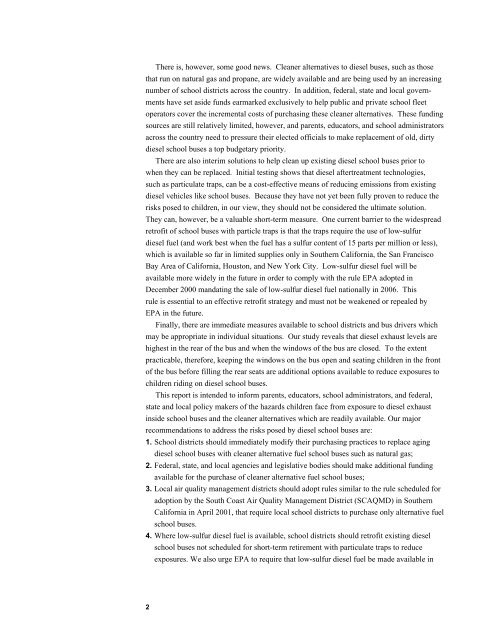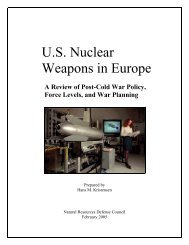NRDC: No Breathing in the Aisles: Diesel Exhaust Inside School ...
NRDC: No Breathing in the Aisles: Diesel Exhaust Inside School ...
NRDC: No Breathing in the Aisles: Diesel Exhaust Inside School ...
Create successful ePaper yourself
Turn your PDF publications into a flip-book with our unique Google optimized e-Paper software.
2<br />
There is, however, some good news. Cleaner alternatives to diesel buses, such as those<br />
that run on natural gas and propane, are widely available and are be<strong>in</strong>g used by an <strong>in</strong>creas<strong>in</strong>g<br />
number of school districts across <strong>the</strong> country. In addition, federal, state and local governments<br />
have set aside funds earmarked exclusively to help public and private school fleet<br />
operators cover <strong>the</strong> <strong>in</strong>cremental costs of purchas<strong>in</strong>g <strong>the</strong>se cleaner alternatives. These fund<strong>in</strong>g<br />
sources are still relatively limited, however, and parents, educators, and school adm<strong>in</strong>istrators<br />
across <strong>the</strong> country need to pressure <strong>the</strong>ir elected officials to make replacement of old, dirty<br />
diesel school buses a top budgetary priority.<br />
There are also <strong>in</strong>terim solutions to help clean up exist<strong>in</strong>g diesel school buses prior to<br />
when <strong>the</strong>y can be replaced. Initial test<strong>in</strong>g shows that diesel aftertreatment technologies,<br />
such as particulate traps, can be a cost-effective means of reduc<strong>in</strong>g emissions from exist<strong>in</strong>g<br />
diesel vehicles like school buses. Because <strong>the</strong>y have not yet been fully proven to reduce <strong>the</strong><br />
risks posed to children, <strong>in</strong> our view, <strong>the</strong>y should not be considered <strong>the</strong> ultimate solution.<br />
They can, however, be a valuable short-term measure. One current barrier to <strong>the</strong> widespread<br />
retrofit of school buses with particle traps is that <strong>the</strong> traps require <strong>the</strong> use of low-sulfur<br />
diesel fuel (and work best when <strong>the</strong> fuel has a sulfur content of 15 parts per million or less),<br />
which is available so far <strong>in</strong> limited supplies only <strong>in</strong> Sou<strong>the</strong>rn California, <strong>the</strong> San Francisco<br />
Bay Area of California, Houston, and New York City. Low-sulfur diesel fuel will be<br />
available more widely <strong>in</strong> <strong>the</strong> future <strong>in</strong> order to comply with <strong>the</strong> rule EPA adopted <strong>in</strong><br />
December 2000 mandat<strong>in</strong>g <strong>the</strong> sale of low-sulfur diesel fuel nationally <strong>in</strong> 2006. This<br />
rule is essential to an effective retrofit strategy and must not be weakened or repealed by<br />
EPA <strong>in</strong> <strong>the</strong> future.<br />
F<strong>in</strong>ally, <strong>the</strong>re are immediate measures available to school districts and bus drivers which<br />
may be appropriate <strong>in</strong> <strong>in</strong>dividual situations. Our study reveals that diesel exhaust levels are<br />
highest <strong>in</strong> <strong>the</strong> rear of <strong>the</strong> bus and when <strong>the</strong> w<strong>in</strong>dows of <strong>the</strong> bus are closed. To <strong>the</strong> extent<br />
practicable, <strong>the</strong>refore, keep<strong>in</strong>g <strong>the</strong> w<strong>in</strong>dows on <strong>the</strong> bus open and seat<strong>in</strong>g children <strong>in</strong> <strong>the</strong> front<br />
of <strong>the</strong> bus before fill<strong>in</strong>g <strong>the</strong> rear seats are additional options available to reduce exposures to<br />
children rid<strong>in</strong>g on diesel school buses.<br />
This report is <strong>in</strong>tended to <strong>in</strong>form parents, educators, school adm<strong>in</strong>istrators, and federal,<br />
state and local policy makers of <strong>the</strong> hazards children face from exposure to diesel exhaust<br />
<strong>in</strong>side school buses and <strong>the</strong> cleaner alternatives which are readily available. Our major<br />
recommendations to address <strong>the</strong> risks posed by diesel school buses are:<br />
1. <strong>School</strong> districts should immediately modify <strong>the</strong>ir purchas<strong>in</strong>g practices to replace ag<strong>in</strong>g<br />
diesel school buses with cleaner alternative fuel school buses such as natural gas;<br />
2. Federal, state, and local agencies and legislative bodies should make additional fund<strong>in</strong>g<br />
available for <strong>the</strong> purchase of cleaner alternative fuel school buses;<br />
3. Local air quality management districts should adopt rules similar to <strong>the</strong> rule scheduled for<br />
adoption by <strong>the</strong> South Coast Air Quality Management District (SCAQMD) <strong>in</strong> Sou<strong>the</strong>rn<br />
California <strong>in</strong> April 2001, that require local school districts to purchase only alternative fuel<br />
school buses.<br />
4. Where low-sulfur diesel fuel is available, school districts should retrofit exist<strong>in</strong>g diesel<br />
school buses not scheduled for short-term retirement with particulate traps to reduce<br />
exposures. We also urge EPA to require that low-sulfur diesel fuel be made available <strong>in</strong>
















